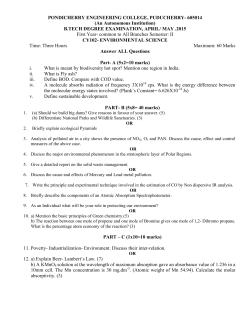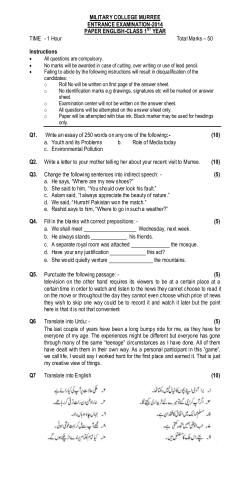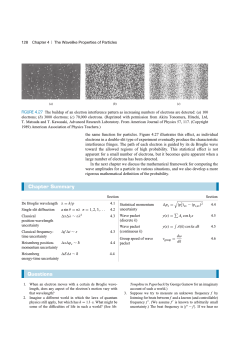
PHYA1_Easter Rev_2_Q
PHYA1_Easter Rev_2 77 minutes 70 marks Page 1 of 11 A car battery has an emf of 12 V and an internal resistance of 5.0 × 10–3 Ω. Q1. (a) (i) Explain what is meant by the emf of the battery. ............................................................................................................. ............................................................................................................. (1) (ii) Explain what is meant by the internal resistance of the battery. ............................................................................................................. ............................................................................................................. (1) (b) The battery is used to provide the starting motor of a car with a current of 800 A. (i) Calculate the potential difference across the terminals of the battery. answer = ................................................... V (2) (ii) Calculate the rate of dissipation of energy due to its internal resistance stating an appropriate unit. answer = ...................................................... (3) (c) State and explain the effect of attempting to use a battery with a much higher internal resistance to start the car. ...................................................................................................................... ...................................................................................................................... ...................................................................................................................... ...................................................................................................................... (2) (Total 9 marks) Page 2 of 11 Q2. The diagram below shows an arrangement of resistors. (a) Calculate the total resistance between terminals A and B. answer = ................................................... Ω (2) (b) A potential difference is applied between the two terminals, A and B, and the power dissipated in each of the 400 Ω resistors is 1.0 W. (i) Calculate the potential difference across the 400 Ω resistors. answer = ................................................... V (ii) Calculate the current through the 25 Ω resistor. answer = .................................................... A Page 3 of 11 (iii) Calculate the potential difference applied to terminals A and B. answer = ................................................... V (6) (Total 8 marks) Q3. (a) Some materials exhibit the property of superconductivity under certain conditions. • State what is meant by superconductivity. • Explain the required conditions for the material to become superconducting. ...................................................................................................................... ...................................................................................................................... ...................................................................................................................... ...................................................................................................................... (3) (b) The diagram below shows the cross–section of a cable consisting of parallel filaments that can be made superconducting, embedded in a cylinder of copper. (i) The cross–sectional area of the copper in the cable is 2.28 × 10–7 m 2. The resistance of the copper in a 1.0 m length of the cable is 0.075 Ω. Calculate the resistivity of the copper, stating an appropriate unit. answer = ...................................................... (3) Page 4 of 11 (ii) State and explain what happens to the resistance of the cable when the embedded filaments of wire are made superconducting. ............................................................................................................. ............................................................................................................. ............................................................................................................. (3) (Total 9 marks) Q4. (a) State what is meant by the wave-particle duality of electrons. ...................................................................................................................... ...................................................................................................................... ...................................................................................................................... (1) (b) Electrons of wavelength 1.2 × 10–10 m are required to investigate the spacing between planes of atoms in a crystal. (i) Calculate the momentum of an electron of this wavelength stating an appropriate unit. momentum of electron = ................................................ (3) (ii) Calculate the speed of such an electron. speed of electron = .............................................. m s–1 (2) Page 5 of 11 (iii) Calculate the kinetic energy of such an electron. kinetic energy of electron = .................................................... J (2) (Total 8 marks) Q5. (a) Figure 1 shows the Feynman diagram for a particular interaction. Figure 1 (i) State the type of interaction involved and name the exchange particle. ............................................................................................................. ............................................................................................................. (2) (ii) State two quantities other than energy and momentum, that are conserved in this interaction. ............................................................................................................. ............................................................................................................. (2) Page 6 of 11 (b) Figure 2 shows the Feynman diagram for another type of interaction. Figure 2 (i) Complete the diagram to show the two particles formed in the interaction and the exchange particle. (3) (ii) Name the type of interaction responsible for this exchange particle. ............................................................................................................. (1) (iii) Energy and momentum are conserved in this interaction. State two other quantities that must be conserved and show that they are conserved in this interaction. ............................................................................................................. ............................................................................................................. ............................................................................................................. (4) (iv) The exchange particle in this interaction was discovered by experiment with a rest mass that had been predicted. Why is it important to test by experiment the prediction of a scientific theory? ............................................................................................................. ............................................................................................................. ............................................................................................................. ............................................................................................................. (2) (Total 14 marks) Page 7 of 11 Q6. When light of a certain frequency is shone on a particular metal surface, electrons are emitted with a range of kinetic energies. (a) Explain • in terms of photons why electrons are released from the metal surface, and • why the kinetic energy of the emitted electrons varies upto a maximum value. The quality of your written communication will be assessed in this question. ...................................................................................................................... ...................................................................................................................... ...................................................................................................................... ...................................................................................................................... ...................................................................................................................... ...................................................................................................................... ...................................................................................................................... ...................................................................................................................... ...................................................................................................................... ...................................................................................................................... ...................................................................................................................... ...................................................................................................................... (6) (b) The graph below shows how the maximum kinetic energy of the electrons varies with the frequency of the light shining on the metal surface. (i) On the graph mark the threshold frequency and label it f0. (1) (ii) On the graph draw a line for a metal which has a higher threshold frequency. (2) (iii) State what is represented by the gradient of the graph. ............................................................................................................. (1) Page 8 of 11 (c) The threshold frequency of a particular metal surface is 5.6 × 1014 Hz. Calculate the maximum kinetic energy of emitted electrons if the frequency of the light striking the metal surface is double the threshold frequency. answer = .................................. J (3) (Total 13 marks) Q7. The diagram below shows part of an energy level diagram for a hydrogen atom. n = 4 _________________ –0.85 eV n = 3 _________________ –1.50 eV n = 2 _________________ –3.40 eV n = 1 _________________ –13.60 eV (a) The level, n = 1, is the ground state of the atom. State the ionisation energy of the atom in eV. answer = ................................... eV (1) (b) When an electron of energy 12.1 eV collides with the atom, photons of three different energies are emitted. (i) On the diagram above show with arrows the transitions responsible for these photons. (3) Page 9 of 11 (ii) Calculate the wavelength of the photon with the smallest energy. Give your answer to an appropriate number of significant figures. answer =.............................. m (5) (Total 9 marks) Page 10 of 11 Page 11 of 11
© Copyright 2025














